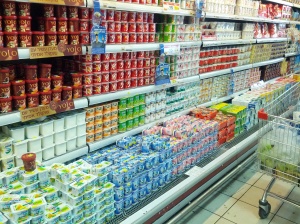
So, you’re looking for yogurt in Israel? Confused much? In the U.S., there is one thing that comes in what we would call a “yogurt container” and that is yogurt.
In Israel, there are dozens of non-yogurt cheese products that come in little plastic containers. You have yogurt, gevinah lavanah (white cheese), cottage cheese, shemenet (sour cream), gil, eishel, etc. Each one of these may come in various fat contents, flavors, and with a myriad of toppings.
What is the difference between them? Which are the tastiest? I set out to answer these questions with some research and a taste test. In this first post I will cover only Tnuva products, since they can be found in any grocery store or makolet. Of these products, I tried two types of yogurt, “Gil”, “Eishel”, “Classic Sheli (My classic)”, and three types of shemenet (sour cream). Below are the pictures of these products with the nutritional breakdown.
Going from left to right, we have Yogurt 4.5% (the percentages on Israeli dairy products always indicate the fat content by weight) and then Yogurt “Danuba” 4%. The Danuba yogurt is labeled “Bio”, which means it still contains the live active cultures used to ferment the milk, producing yogurt. Yogurt without the “Bio” label has been heat treated after fermentation, killing the cultures.
Next, we have Eishel, Gil, and Classic Sheli, which are exclusively Tnuva products. They are types of gevinah lavanah (white cheese) which supposedly are produced the same way and are interchangeable in recipes, depending on your taste.
Next, we have three types of shemenet, similar to sour cream, at 9, 15, and 27% fat content. To give you some reference, Daisy brand sour cream sold in the U.S. has 17% fat, and its light version has 8% fat.
OK, now for the taste test!
First up, the plain ol’ yogurt (4.5%): It tastes…just like yogurt. Creamy, but light, a little tangy.
Danubah yogurt (4%, “bio”): Compared to the 4.5% yogurt this one has a smoother, creamier texture, with less tang. I find it more pleasant.
Eishel (4.5%): It is noticeably lumpy, and the flavor is distinctly like buttermilk, without the characteristic tang of yogurt. It’s basically like eating a more cultured or solidified version of buttermilk, so if you like buttermilk, you will like this.
Gil (3%): The texture is similar to Eishel – a bit lumpy. The flavor is actually very interesting. Compared to the Eishel, it has the same buttermilk taste, but is less tangy and sweeter.
Classic Sheli (4.3%): This one has the appearance of the Bio yogurt. It looks very creamy and smooth with no lumpiness. This seems almost identical to Gil except for the texture. Like, creamy yogurt texture meets subtle sweet buttermilk flavor of Gil.
Now for the shemenet…
9% (green container): This one begins quite solid with liquid sitting on top. After stirring it is quite thick…thicker than the yogurt/gil/eishel which all had about the same thickness. In tasting right away I am struck by the richness of the shemenet. It is 9% fat after all! The flavor reminds me most of sour cream, and also the most like Gil. Very tasty.
15% (blue container): This one, as expected, begins even more solid with less liquid sitting on top. After stirring it is even thicker than the 9%, approaching a whipped cream cheese. The taste is exactly like sour cream from home. It feels like as you go up in fat content, the taste becomes less pronounced and it’s more about the texture.
27% (gold container) aka shemenet shel paam: This starts out very thick and is not so easy to stir. The color is slightly more yellow than all the previous samples, more like butter. It looks a bit like a frosting. The taste and texture is like a mix between sour cream and cream cheese. I imagine this would be good as a base for cream cheese frosting, or sandwich spread, or dip, but much too fatty to enjoy on its own with a spoon.
After tasting all of these varieties, there is something I would like to call a “Tang factor” which is most pronounced in the yogurt and least pronounced in the shemenets. After tasting the shements, going back to the yogurt was like sucking on a lemon.
Tang factor: Yogurt (most tangy)> Yogurt Bio>Eishel > Gil>Classic Sheli>9%>15%>27% (least tangy)
After my taste test, here are some personal guidelines that may be helpful for you:
If you want…
Just yogurt ->go with the Danubah Bio yogurt, because if you’re not eating yogurt with active cultures, what is the point?
Buttermilk on a spoon -> Eishel or Gil
Something pleasant and creamy but not too tangy -> Classic Sheli
A replacement for American sour cream-> Shemenet 15%
A replacement for American “light” sour cream-> Shemenet 9%
Creamy cheese for use in recipes like dips or frostings -> Shemenet 27%
That’s all for now, I hope it’s helpful! Now I have to figure out what to do with eight 25% eaten yogurt containers!


Wow! Very informative – I definitely just had 3 categories in my mind (yogurt, gvina levana, and shemenet), but now I see what I was missing. I never would have associated the taste of gvina levana with buttermilk. Also, I will have to try this 27% shemenet.